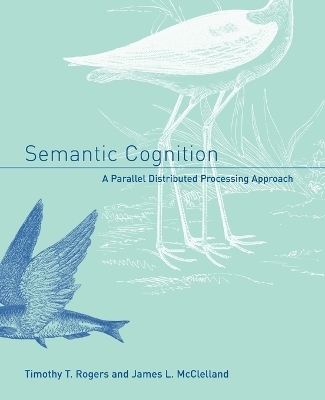
Semantic Cognition
A Parallel Distributed Processing Approach
Seiten
2006
Bradford Books (Verlag)
978-0-262-68157-5 (ISBN)
Bradford Books (Verlag)
978-0-262-68157-5 (ISBN)
- Lieferbar
- Versandkostenfrei
- Auch auf Rechnung
- Artikel merken
A mechanistic theory of the representation and use of semantic knowledge that uses distributed connectionist networks as a starting point for a psychological theory of semantic cognition.
This groundbreaking monograph offers a mechanistic theory of the representation and use of semantic knowledge, integrating the strengths and overcoming many of the weaknesses of hierarchical, categorization-based approaches, similarity-based approaches, and the approach often called "theory theory." Building on earlier models by Geoffrey Hinton in the 1980s and David Rumelhart in the early 1990s, the authors propose that performance in semantic tasks arises through the propagation of graded signals in a system of interconnected processing units. The representations used in performing these tasks are patterns of activation across units, governed by weighted connections among them. Semantic knowledge is acquired through the gradual adjustment of the strengths of these connections in the course of day-to-day experience.
The authors show how a simple computational model proposed by Rumelhart exhibits a progressive differentiation of conceptual knowledge, paralleling aspects of cognitive development seen in the work of Frank Keil and Jean Mandler. The authors extend the model to address aspects of conceptual knowledge acquisition in infancy, disintegration of conceptual knowledge in dementia, "basic-level" effects and their interaction with expertise, and many findings introduced to support the idea that semantic cognition is guided by naive, domain-specific theories.
This groundbreaking monograph offers a mechanistic theory of the representation and use of semantic knowledge, integrating the strengths and overcoming many of the weaknesses of hierarchical, categorization-based approaches, similarity-based approaches, and the approach often called "theory theory." Building on earlier models by Geoffrey Hinton in the 1980s and David Rumelhart in the early 1990s, the authors propose that performance in semantic tasks arises through the propagation of graded signals in a system of interconnected processing units. The representations used in performing these tasks are patterns of activation across units, governed by weighted connections among them. Semantic knowledge is acquired through the gradual adjustment of the strengths of these connections in the course of day-to-day experience.
The authors show how a simple computational model proposed by Rumelhart exhibits a progressive differentiation of conceptual knowledge, paralleling aspects of cognitive development seen in the work of Frank Keil and Jean Mandler. The authors extend the model to address aspects of conceptual knowledge acquisition in infancy, disintegration of conceptual knowledge in dementia, "basic-level" effects and their interaction with expertise, and many findings introduced to support the idea that semantic cognition is guided by naive, domain-specific theories.
Timothy T. Rogers is a research scientist at the Medical Research Council Cognition and Brain Sciences Unit in Cambridge, England. James L. McClelland is Professor of Psychology and Director of the Center for Mind, Brain, and Computation at Stanford University. He is the coauthor of Parallel Distributed Processing (1986) and Semantic Cognition (2004), both published by the MIT Press. With David E. Rumelhart, he was awarded the 2002 University of Louisville Grawemeyer Award for Psychology for his work in the field of cognitive neuroscience on a cognitive framework called parallel distributed processing and the concept of connectionism.
| Reihe/Serie | A Bradford Book |
|---|---|
| Zusatzinfo | 56 illus.; 56 Illustrations |
| Verlagsort | Massachusetts |
| Sprache | englisch |
| Maße | 178 x 229 mm |
| Gewicht | 658 g |
| Themenwelt | Geisteswissenschaften ► Psychologie ► Allgemeine Psychologie |
| Geisteswissenschaften ► Psychologie ► Verhaltenstherapie | |
| ISBN-10 | 0-262-68157-9 / 0262681579 |
| ISBN-13 | 978-0-262-68157-5 / 9780262681575 |
| Zustand | Neuware |
| Informationen gemäß Produktsicherheitsverordnung (GPSR) | |
| Haben Sie eine Frage zum Produkt? |
Mehr entdecken
aus dem Bereich
aus dem Bereich
Lernen, Emotion, Motivation, Gedächtnis
Buch | Softcover (2025)
Beltz (Verlag)
CHF 39,20
Wahrnehmung, Aufmerksamkeit, Denken, Sprache
Buch | Softcover (2025)
Julius Beltz (Verlag)
CHF 39,20


